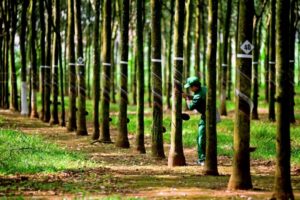Sri Lanka rubber plantations overrun with circular leaf spot disease
Colombo, Sri Lanka – The latest rubber market report by Forbes & Walker Commodity Brokers revealed that about 51 percent of rubber plantations in Sri Lanka have been affected by the Circular Leaf Spot Disease (CLSD).
As per the estimates of the Rubber Development Department, out of the 98,000 hectares of rubber plantations, over 50,000 hectares are impacted by the disease.
The adverse weather conditions, such as the continuous rains Sri Lanka has been experiencing in the past few months, have also disturbed the harvesting process, aggravating the situation.
When the CLSD was reported first five years ago, approximately 10,000 hectares in the Kalutara, Ratnapura and Galle districts in the low-country wet zone areas were affected. The extent of the affected plantation then increased to 20,000 hectares in 2020 and 40,000 hectares in 2021.
As per the Rubber Research Institute, rubber production in 2012 was at 152,100 MT and in 2022 the output dropped to less than half that volume, recording 70,870 MT.
The CLSD is said to have originated first in Malaysia in 1987 and again in 2003, before eventually making its way to Sri Lanka. It has also reportedly spread to neighbouring rubber-producing Asian countries such as Indonesia, Malaysia and Thailand. However, it does not seem to affect the rubber-producing countries in Africa, which could be due to the humidity levels when compared with Asia.
Meanwhile, according to the Planters’ Association, rubber production is expected to reach just 60 million kilogrammes by the end of 2023. National rubber production has incurred an estimated loss of around US $ 12 million from 2021 to 2022 alone.
The Planters’ Association also called for greater support on key reforms outlined in the Rubber Industry’s Master Plan and research into biological and mechanical methods to enhance productivity.
Sri Lanka needs about 140,000 MT of rubber for local consumption but produces only half of this amount at present. The rubber plantations and rubber product manufacturers under the value-added sector bring in about US $ 1.1 billion by way of forex.

